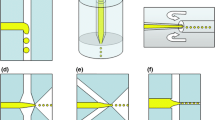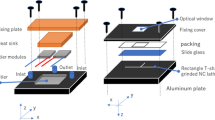Abstract
The effect of microbubble emission boiling (MEB) on the mixing of two fluids in a microfluidic device was studied experimentally. When MEB occurred on an electric heater made of a platinum wire with a diameter of 30 micrometers, the mixing of the two fluids increased markedly. However, nucleate boiling had no significant effect on the mixing. A high-speed video showed that the very rapid growth and collapse of micro boiling bubbles on the heater causes the strong mixing of the two fluids. The coexistence of highly superheated and highly subcooled water near the heater seems to be the reason for such enhanced mixing.
Similar content being viewed by others
References
Chaktranond, C., Fukagata, K., Kagagi, N., Performance assessment and improvement of a split-and-recombine micromixer for immunomagnetic cell sorting, J. Fluid Science and Technology, Vol 3, No. 8 (2008) 1008–1019
Hamanaka, O. and Kato, H., Quantitative evaluation of mixing efficiency of split-and-recombine mixing method, 3rd Int. Conf. on Microchannels and Minichannels, ASME, Toronto, ICMM2005-75053 (2005).
Jin, Z., Simeya, S., Okamoto, K., and Hu, H., Mixing enhancement in a microfluidic device, J. Visualization, Vol. 11, No. 1 (2008) 35–36.
Koizumi, Y., Shimoju, N., and Ohtake, H., Study on micro pump using boiling bubbles in microchannel, Therm. Sci. & Eng., Vol. 12, No. 4 (2004) 63–64.
Shoji, M., Tange, M., Watanabe, M., Yuasa, M., and Takagi, S., Microbubble emission boiling: Fundamental features and its possible application to microchannel cooling device, HEAT2005 Gdansk, Poland, June 2005.
Stroock, A.D., Dertinger, S. K.W., Ajdari, A., Mezic, I., Stone, H. A., and Whitesides, G. M., Chaotic mixer for microchannels, Science, 295 (2002) 647–651
Tan, W.-H., Suzuki, Y., Kasagi, N., Shikazono, N., Furukawa, K., and Ushida, T., A lamination micromixer for μ -immunomagnetic cell sorter, JSME Int. J., Ser. C, Vol. 48 (2005), 425–435.
Author information
Authors and Affiliations
Additional information
Hiroharu Kato: He received his M.Sc (Eng.) in Mechanical Engineering in 1963 from University of Tokyo. He also received his Ph.D. in Mechanical Engineering in 1966 from University of Tokyo. He worked at the Department of Naval Architecture, later the Department of Environmental & Ocean Engineering, University of Tokyo until 1999. He was professor at the Department of Mechanical Engineering, Toyo University in 1999–2009. His research interests are cavitation, environmental engineering and energy engineering.
Masayoshi Yamaguchi: He received his M.Sc. (Eng.) degree in Mechanical Engineering in 2007 from Toyo University. At present, he works for Ageo East Junior High School.
Rights and permissions
About this article
Cite this article
Kato, H., Yamaguchi, M. Enhancement of mixing by microbubble emission boiling in a microfluidic device. J Vis 12, 267–274 (2009). https://doi.org/10.1007/BF03181865
Received:
Revised:
Issue Date:
DOI: https://doi.org/10.1007/BF03181865




